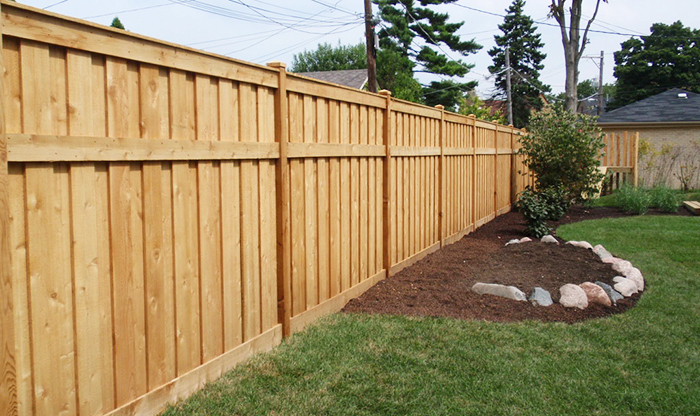
Although putting up a fence can seem like a major hassle, there are some things you can do to make it work quickly. Installing split rail fencing is easy. Dig the holes, then install the rails. Next, place the first piece of post in the hole. Fill in the gap around the first post with the rails. Install the second post on top of the first. Follow these steps to install it.
To start installing the fence, start with a 2-inch guide piece. Next, align the first board flush to the end of your post. Next, place the second board flush against the guide piece. To secure the rails, screw each side. You don't have to drill holes for every post. This will save you money. Also, you don't need to worry about ensuring the posts are positioned perfectly.

After the posts are installed, it's now time for the split rail fence to be put up. It will take some administrative work to ensure it is correctly installed. To get a property inspection, for example, you will need to do some administrative work. You don't usually need to buy the document separately. If you cannot find the original, it is possible to order one online. Once you have it you will be able to begin building your splitrail fence.
Once you've installed the fence posts, you'll need to install the rails. There are two types. Line posts form the bulk of split rail fencing and are completely drilled for rails. Corner posts provide the perfect angles and are the fence's endpoint. For DIY projects, a measuring tape, a level and a hole auger can be useful.
Before placing the posts you need to measure them. Mark the corners posts and end posts to determine the corners of your split-rail fence. The same measurements should be used for the posts and rails. Measure the length of your fence in yards after the posts have been installed. You should also measure the length of the posts. Once the fence is complete, you can add concrete to the corners and endposts.

Before installing split rail fences, measure your property. It's important to know how many feet you'll need for the fence to be installed properly. If cedar siding is your choice, you will need to purchase 11-foot-long rails. You will then need to cut the rails according to the dimensions of your property. If you're going to put the fence in the yard, you should measure the area where you want it to be located.
FAQ
What is the average time it takes to renovate a house?
It all depends on how big the project is and how much time you spend each day. The average homeowner spends three to six hours each week working on the project.
What should I consider when buying a new home?
Before purchasing a new home, make sure that you have enough money saved up to cover closing costs. Refinancing your mortgage might be an option if you don’t have enough cash.
Is it better to remodel an older house than build a brand new one?
There are two options if your goal is to build a new home. The other option is to purchase a prebuilt home. These homes are ready to be moved into and have already been built. Another option is to build a custom home yourself. This option will require you to hire a builder in order to design and build your dream house.
The cost of building a new home depends on how much time and money you spend designing and planning it. You'll probably need to do the majority of the construction work yourself if you build a custom home. This will require more effort. But you can choose the materials you want and where you want them to be placed. It might be easier to find a contractor that specializes in custom-built homes.
A new home is usually more expensive than a remodeled home. You'll have to pay more for land and any improvements. In addition, you will need to pay permits and inspections. On average, the difference in price between a new and remodeled house is $10,000 to $20,000.
Statistics
- Most lenders will lend you up to 75% or 80% of the appraised value of your home, but some will go higher. (kiplinger.com)
- It is advisable, however, to have a contingency of 10–20 per cent to allow for the unexpected expenses that can arise when renovating older homes. (realhomes.com)
- They'll usually lend up to 90% of your home's "as-completed" value, but no more than $424,100 in most locales or $636,150 in high-cost areas. (kiplinger.com)
- ‘The potential added value of a loft conversion, which could create an extra bedroom and ensuite, could be as much as 20 per cent and 15 per cent for a garage conversion.' (realhomes.com)
- Design-builders may ask for a down payment of up to 25% or 33% of the job cost, says the NARI. (kiplinger.com)
External Links
How To
How to Renovate an An Old House
Before you start, it is essential that you decide which type of renovation project to undertake. This could be anything from updating your kitchen appliances to completely renovating the house.
After you've determined the type of renovation you want, you should consider how much money you can spend. Sometimes, you might not have enough money to pay the full project cost. This is a sign that you may not have enough funds to cover the entire cost of the project.
There are many things to remember before you begin work if you have decided to do renovations. You must ensure you have all the permits needed for the job. You should also check whether you require planning permission for certain types of work. If you are planning to make extensions to your house, you may need to apply to the building consent.
Before you start work on the house it is best to check with the local council website to determine if additional permits are required. It is also important to check whether planning permission is required for every part of the house you are renovating. To make sure you have enough coverage, contact your insurance provider if you intend to perform any major works, such as installing new roofs.
The next step after getting all the permits you need is to choose the right tools and materials for the job. There are many options, so take the time to thoroughly research them. Paint, wallpaper paste, carpets and tiles are some of the most commonly used items in renovations.
You should consider the product's overall quality when shopping for these items. Cheap products tend to last only a short period of time, whereas good quality products will usually last longer and provide better value for money. You should only buy what you need when purchasing anything. It's important to not buy too much. You could waste valuable resources and end up with a lot of wasted material. Instead, try to purchase exactly what you need.
Once you have chosen the materials, it is time to plan where you will store them while you work on the property. Renting storage space might be necessary if you plan on renovating a large part of your home. This will allow you to store all your supplies until you have them ready to go. Alternatively, you could ask family members or friends to help you move all the items around.